High-value email marketing can grow your customer base, drive revenue, and keep you on the cutting edge of customer experience. But for the email marketing software you choose to work for you, it needs to be flexible, easy to use, and deliver relevant emails with a clean layout that look great on any device.
You want to grow your business – and need email marketing software that’s easy to use, affordable, and will nurture and convert potential customers.
It should be simple, but with an overwhelming 450+ email marketing tools to choose from – and with every email marketing company’s website saying the same thing, it’s anything but simple.
To identify the best email marketing software for different businesses we surveyed 1,782 marketers ranging from small business owners to Fortune 500 CMOs, who were in the process of changing email marketing software to understand which tool they’re moving from and to – and why.
Here’s our verdict of the 10 Best Email Marketing Tools for 2022:
- ActiveCampaign – best overall email marketing software
- HubSpot – a good option for B2B service companies
- Sendinblue – a good option for transactional email
- Drip – a good option for e-commerce businesses
- Omnisend – another good option for e-commerce businesses
- Autopilot – a good option for advanced marketing automation
- Benchmark – a good option for agencies
- MailerLite – a good option for personal projects
- ConvertKit – a good option for bloggers
- EmailOctopus – a good option for developers
Read on to find out what our survey and testing revealed about each tool’s strengths and weaknesses across nine areas; cost, deliverability, integrations, ease-of-use, reporting, security, features, CRM, and support.
___
#1 ActiveCampaign
Best overall email marketing software
With over 130,000 customers, ActiveCampaign was the most commonly mentioned tool that survey respondents were planning to choose for email marketing software in 2022.
ActiveCampaign have earned their reputation as a leading email marketing automation tool by focusing on building a world-class product.

ActiveCampaign’s automation builder makes building automations easy, similar to using a flowchart
It’s by far the most advanced email marketing platform in our list, with machine learning and predictive tools enabling marketers to work smarter and deliver higher ROI.
Often credited for pioneering visual marketing automation, ActiveCampaign is impressively intuitive and easy-to-use compared to some of the tools on our list.
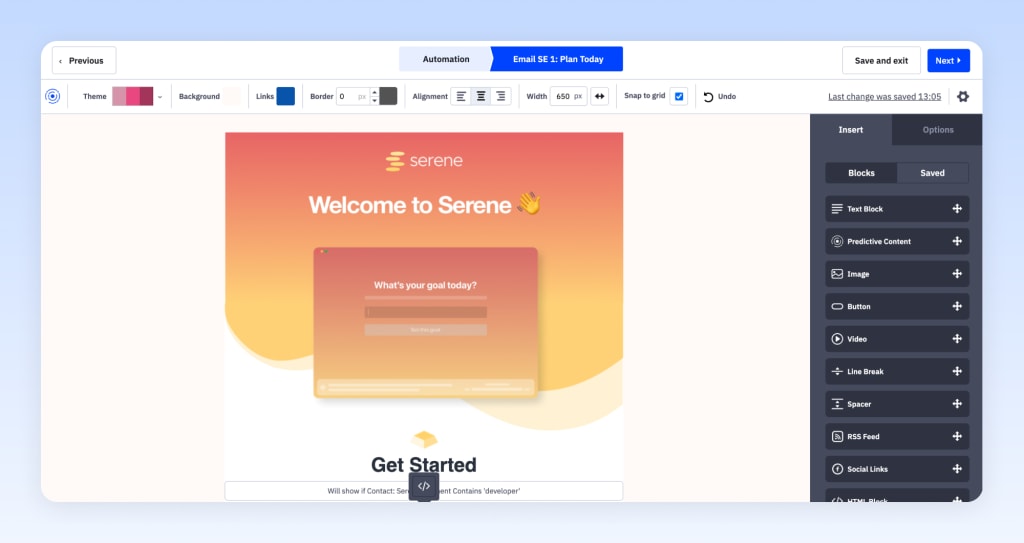
ActiveCampaign’s intuitive drag-and-drop email marketing designer
And while the tip of the iceberg that you see with ActiveCampaign is category-leading, so is what’s below the surface. Their deliverability rates are exceptional (>99%), they integrate with 870+ third-party tools, and go far above and beyond with their security and compliance measures.
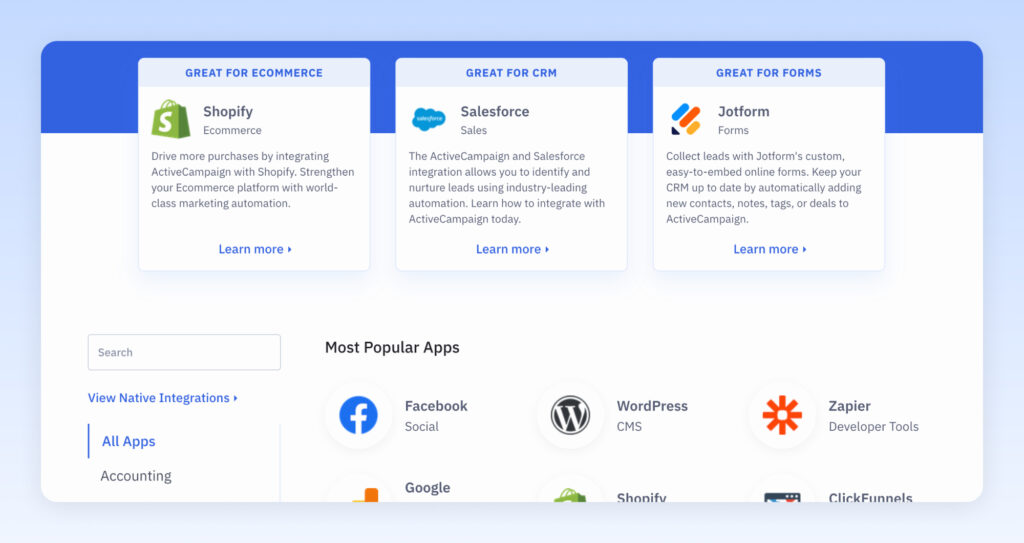
ActiveCampaign offers 870+ integrations including native integrations with Salesforce, Shopify, Google Sheets, Slack & more.
As an all-in-one sales and marketing tool, ActiveCampaign comes with an in-built CRM system to manage yours sales, live chat, and of course email marketing automation in one place.
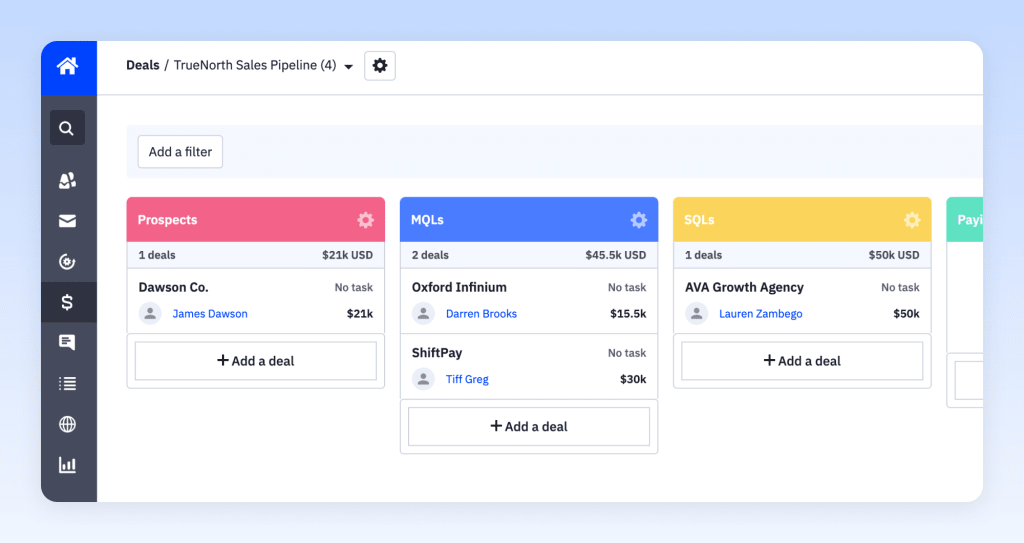
A built-in sales CRM makes it easier to manage deals, but also connects to ActiveCampaign’s powerful automation engine
You’d be forgiven for thinking all of this might come at a hefty cost. Yet, starting at $9/mo, ActiveCampaign is reasonably priced and more affordable than many of the tools in this list.
ActiveCampaign recently published their Customer Success Commitment, which outlines 22 guarantees from their support team including free implementation and migration.
ActiveCampaign’s notable features:
- 125+ Email templates
- 500+ Automation recipes
- 870+ Integrations
- Send SMS, site messages & email
- Landing pages
- CRM
- Split actions and A/B Testing
- Goal tracking, attribution & sales analytics
- Predictive content, sending & deal win probability
ActiveCampaign offers a free 14-day trial with no credit card required.
#2 HubSpot
A good option for B2B service businesses
HubSpot is world-class in offering businesses an all-in-one sales and marketing platform that includes a CRM, landing pages, email marketing, marketing automation, chat, forms, and everything in between.
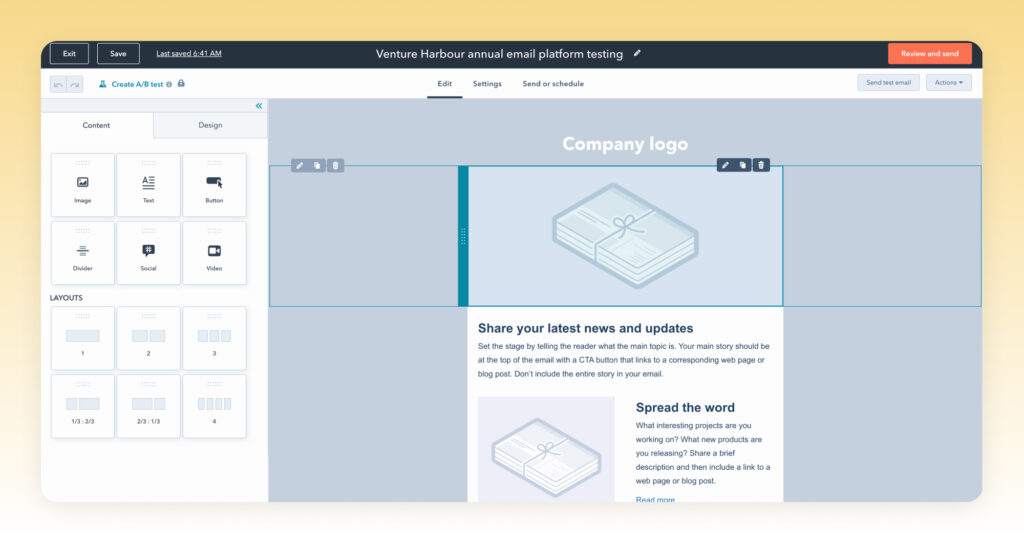
While some argue that trying to do everything is HubSpot’s downfall, it does enable them to do one thing exceptionally well; Reporting.
“Half the money I spend on advertising is wasted; the trouble is I don’t know which half.”
– John Wanamaker
By using HubSpot as the backbone of your marketing and sales, you can more easily attribute revenue back to the marketing campaign, newsletter, or blog post that influenced each sale. In this sense, HubSpot is more of a CRM that offers email marketing and automation, rather than vice versa.
And if your website is built on WordPress, then you get an extra advantage to using HubSpot as your email marketing tool. HubSpot has a WordPress plugin that gives you the ability to send email campaigns directly from WordPress. The plugin also lets you use a HubSpot form or chat widget to automatically capture contacts in your CRM, all without leaving WordPress.
Hubspot can come at a cost
While much-loved, HubSpot is the second most likely response (behind Mailchimp) to “Which email marketing software are you leaving?” in our survey of 1,700+ email marketers. The reason is almost always the same; Price.
HubSpot position themselves as an affordable option for small businesses by offering free versions of their products – but don’t be fooled by the HubSpot gateway-drug. Their platform becomes exponentially expensive as your list or feature requirements grow.
One business owner I spoke with started on a $50/month plan, and within a year needed a $2,000/month plan that had to be paid annually. The only difference was an extra 15,000 contacts and adding marketing automation, yet they jumped from seeing $50 leave the bank to $24,000.
This is where I feel conflicted about HubSpot.
On the one hand, you could get the same functionality for one-tenth of the price using ActiveCampaign, Benchmark, or half of the tools in this guide. On the other hand, if the value of knowing what influenced each sale is a problem worth paying a five-figure sum to solve, then HubSpot is a strong contender.
This is why we suggest that HubSpot is an ideal choice for B2B service companies, where the value of winning a handful of extra clients a year would easily cover the cost of HubSpot. This extends to larger, or more sophisticated, agencies that must provide clients with in-depth reports on their marketing funnel.
If you just need email marketing software, HubSpot is possibly overkill. But if your search for email marketing software is part of a wider plan to raise to your marketing game and improve performance across your entire sales and marketing funnel, HubSpot is a strong contender – but don’t expect it to come cheap.
#3 Sendinblue
A good option for transactional email
Sendinblue is best-known as one of the leading transactional email services. Building on this reputation they built an email marketing automation product.
We use Sendinblue to send transactional emails for two of our ventures (Leadformly and Serene), as they’re one of the few email marketing providers with servers in the European Union (which helps with our GDPR compliance) and they have good deliverability rates (we’re currently at 98%).
While I can’t comment on their marketing automation features from first-hand experience, it’s evident from our customer surveys that it’s good, but lacks some of the more advanced features (such as goal tracking, native integrations, and annotations).
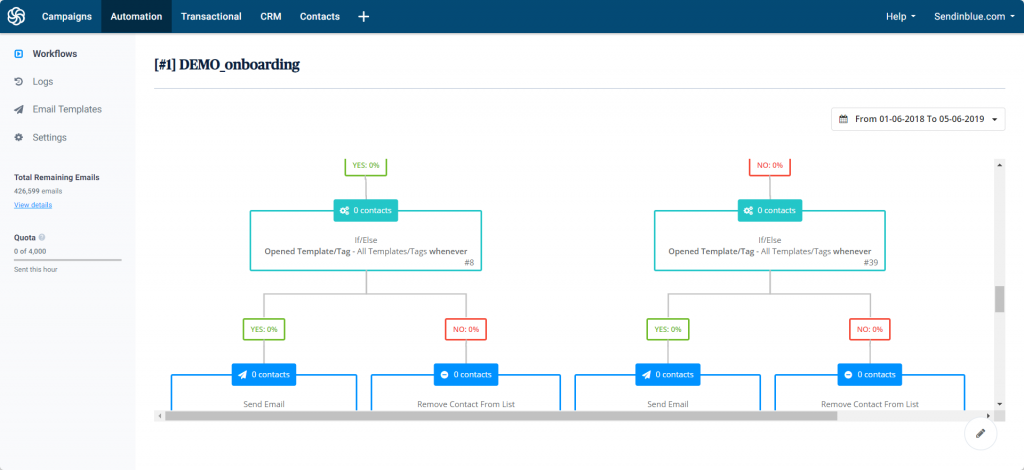
If you need an email marketing tool with a solid API to get your emails into inboxes with a good deliverability rate, Sendinblue’s pre-built developer recipes make it an excellent choice.
What are Sendinblue’s key features?
- Marketing automation
- SMS
- Live chat
- CRM
- Transactional email
- Landing pages
- Sign-up forms
- Facebook Ads
#4 Drip
A good option for smaller e-commerce stores
I think it’s fair to say that Drip’s focus is on smaller to medium-sized e-commerce businesses, whereas our next email marketing tool (Omnisend) seems better suited to the larger e-commerce stores.
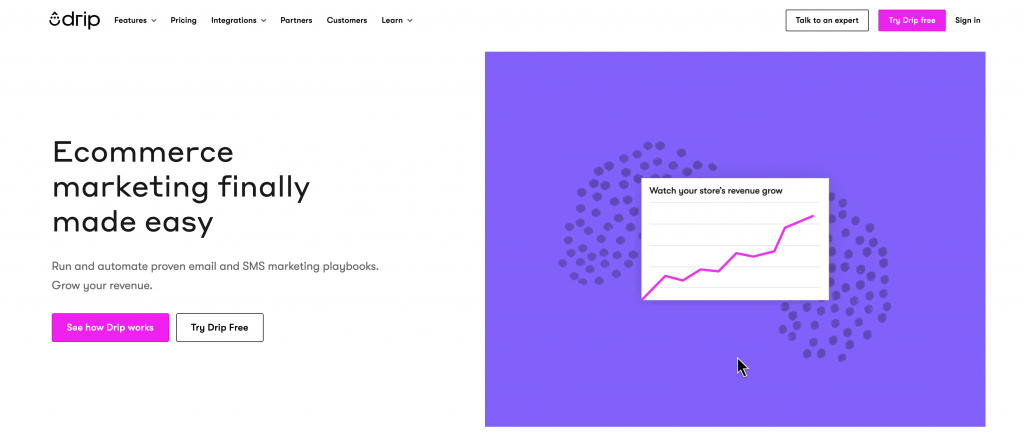
As you’d expect, Drip integrates deeply with all mainstream e-commerce platforms like Shopify, Magento and WooCommerce – as well as the more obscure and custom-made ones.
With built-in revenue analytics and tools to engage customers across multiple channels (from social channels to SMS) Drip is ideally positioned as a powerful tool for growing e-commerce stores.
Their pricing is also palatable, starting at $19/month for small list sizes.
What are Drip’s key features?
- Visual automation
- Email and SMS marketing
- Dynamic e-commerce content blocks
- Discount codes
- e-commerce Segmentation
- Retargeting
- e-commerce store integrations
- Reporting dashboards
- Split testing sequences
#5 Omnisend
A good option for medium-large e-commerce brands
Omnisend is quickly becoming one of the leading marketing platforms for e-commerce stores.
Designed to help e-commerce brands control their marketing across multiple channels, Omnisend offers automated email, SMS, push notifications, and most impressively, integrations with Google Ads, Instagram, Facebook Ads, Messenger, and WhatsApp – which they claim have 10X higher click-through rates than email.
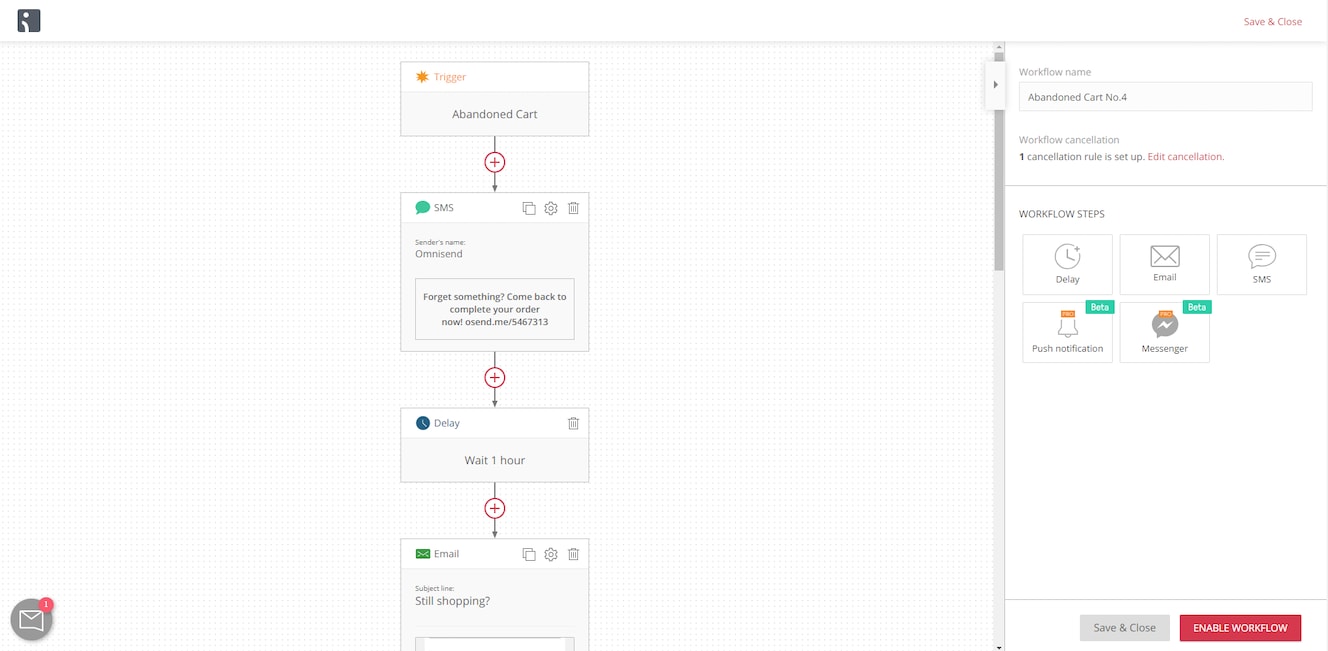
By focusing purely on e-commerce, Omnisend has built innovative email templates designed to reduce cart abandonment and drive repeat buyers. From ‘wheel of fortune’ offers to virtual scratch cards and birthday discounts, it’s evident that Omnisend’s built by a team intimately aware of what works in e-commerce.

As you’d expect of an e-commerce email marketing tool, Omnisend hooks into most e-commerce platforms, including Magento, Shopify, and BigCommerce. Where Omnisend goes one step further is in integrating with review, loyalty and help desk platforms, such as Yotpo, Smile.io, and ReCharge.
This not only enables Omnisend to report on how your campaigns impact sales, but enables you to trigger email, SMS and social campaigns based around your customer behaviour to reduce cart abandonment, increase return buyers, drive more product reviews, and more.
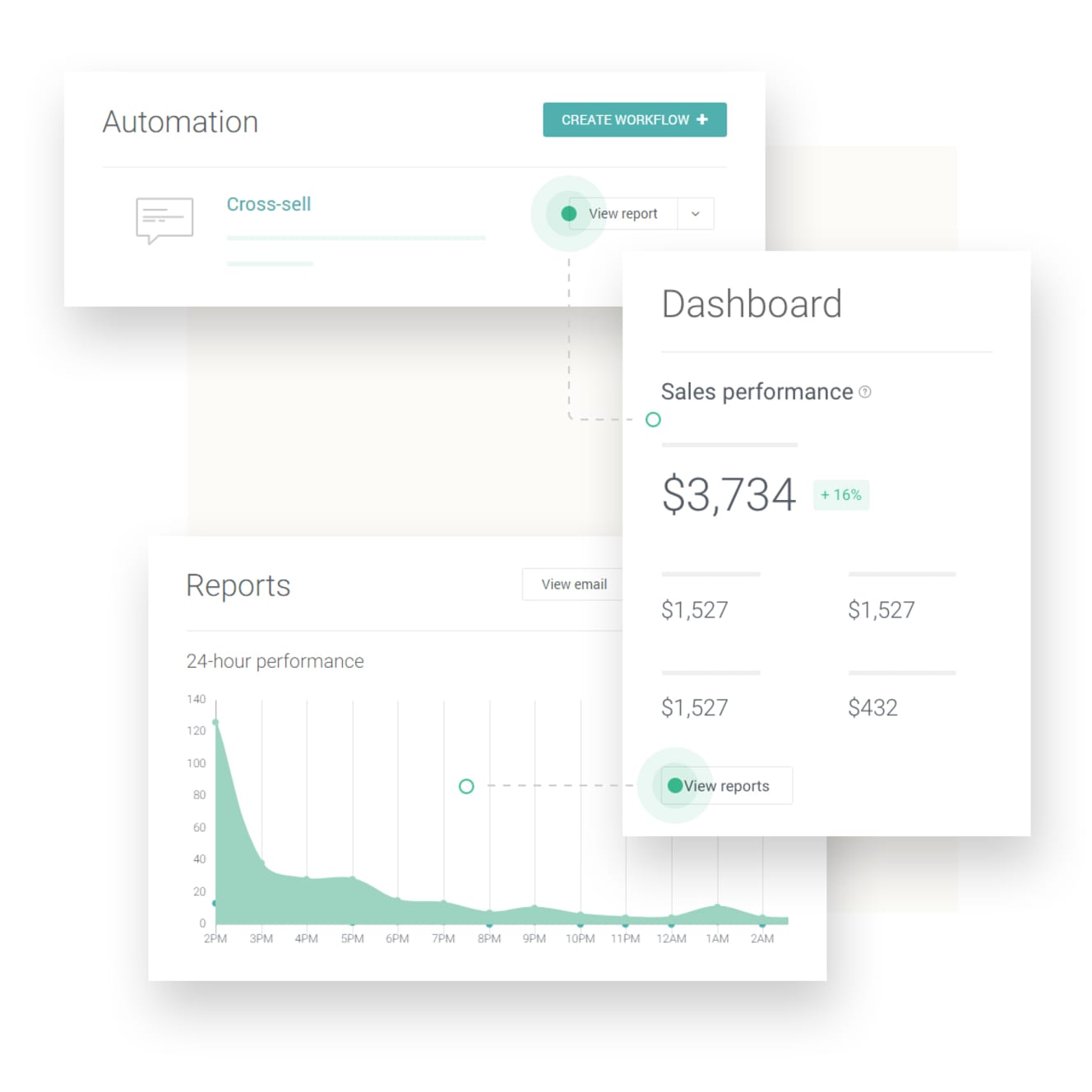
If you want the features that make Omnisend stand out, you’ll need a PRO account which starts at $199/month for up to 10,000 contacts. While not the cheapest, nor the easiest to use, Omnisend is a good option for e-commerce brands that want one multi-channel platform to rule them all.
What are Omnisend’s key features?
- Visual email builder
- Email, SMS and Push notifications
- Transactional and marketing emails
- Dynamic discount codes
- e-commerce Segmentation
- Retargeting
- Surveys and Polls
- Reporting
- Popups and forms – wheel of fortune, scratch cards etc.
- A/B Testing
#6 Autopilot
A good option for marketing automation
Gone are the days where email marketing is about sending bulk newsletters.
In today’s digital landscape, it’s essential for email marketing to be smart; sending the right messages to the right leads at the right time, automatically.
That’s why all of our top ten email marketing providers provide marketing automation. As the name would suggest, this is Autopilot’s forte. To boot, they have one of the best-designed canvases for building email automation sequences.

Anyone who has ever built an email automation sequence knows how quickly they can become confusing. Autopilot solves this in a rather quirky way, allowing you to annotate your automation sequences with emojis, stickers and explanations, making it easy for teams to collaborate on building sequences.
Yes, it can get messy – but I’d rather that and be able to understand what’s going on, than having beautiful automation sequences that take half an hour to interpret.
Another feature I love about Autopilot is its ability to trigger actions in your other tools inside Autopilot. This saves having to configure integrations using a tool like Zapier and makes your sequences much easier to understand.
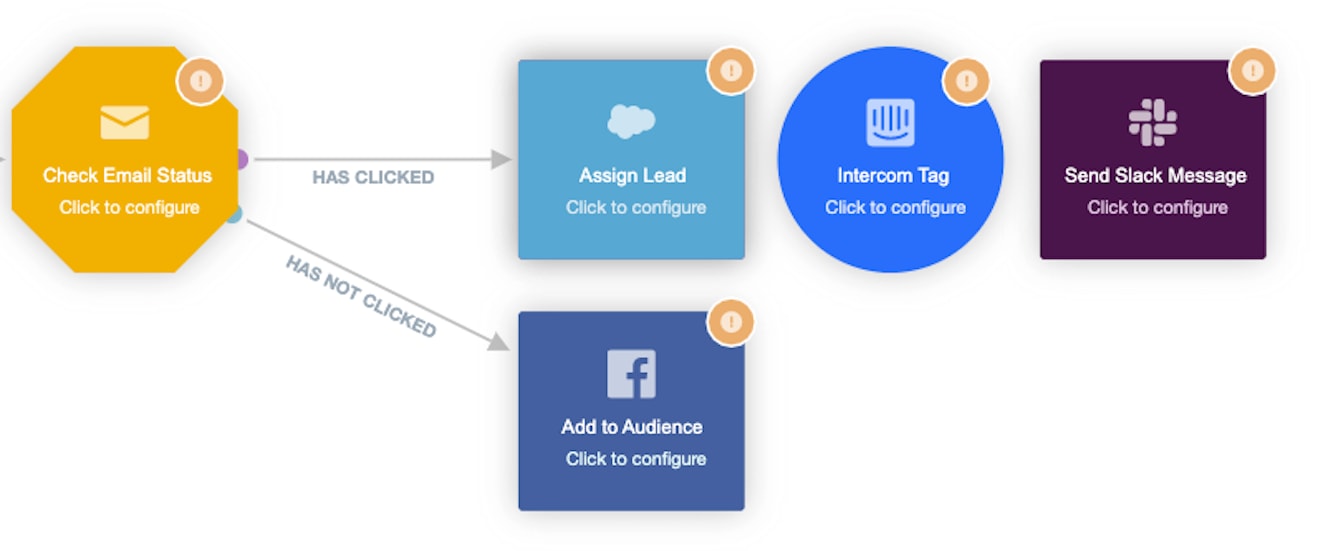
Autopilot’s reporting is also excellent, though, I’ll go into this in more detail in our section on reporting and analytics below.
Starting at $49/month for 2,000 contacts, Autopilot is far from the cheapest option, particularly considering that Autopilot does not offer an in-built CRM. However, Autopilot is extremely intuitive and great for teams that need to collaborate on powerful email automation sequences. If we had to move from ActiveCampaign, this is likely where we’d go.
#7 Benchmark
A good option for agencies
Benchmark is an interesting option for any business looking for a well-designed and easy-to-use email marketing tool.
While not quite as well known as other tools in the top ten, they’ve become an increasingly popular response to “Which tool are you moving to?” in our survey.
Benchmark do everything pretty well and are reasonably priced, but there’s one thing that really sets them apart from other email marketing tools – and that’s design.
Everything from their templates to the platform itself is beautifully-designed – and not just visually attractive, but great user experience. While that may seem trivial to some, it makes all the difference when it comes to understanding your data and creating the right impression with contacts.
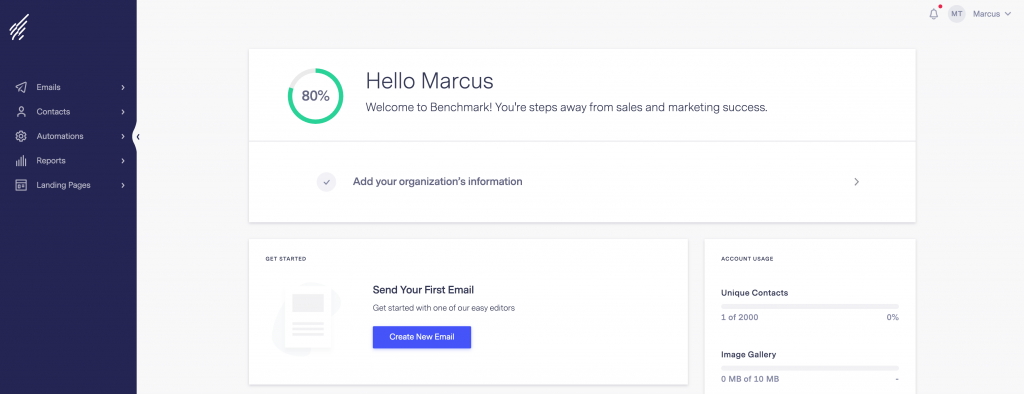
Benchmark is a good choice for any small business that needs simple, easy-to-use email marketing and automation software. It’s likely to be a particularly good choice for small agencies and consultancies where design is important both from a staff training perspective – and also providing a good experience for clients.
What are Benchmark’s key features?
- Visual email builder
- Marketing automation
- 1,500+ Integrations
- Landing pages
- Surveys and Polls
- Reporting
- Sign-up forms
- A/B Testing
Hit your growth goals
TrueNorth is the Growth Marketing Platform to focus, align, and track marketing in one place, with everything and everyone working towards your goal
#8 ConvertKit
A good option for bloggers
ConvertKit is a relatively simple email marketing tool used almost exclusively by bloggers and online course instructors to develop their personal brands.
Their platform has no bells or whistles. It doesn’t even have email templates, as ConvertKit encourages its users to send plain-text emails to increase engagement. As most of its users are individuals trying to build a personal brand this makes sense, but it does make ConvertKit a poor-fit for other use cases.
If you’re a creator that just needs a simple tool to serve your audience with regular content, there’s no better tool.
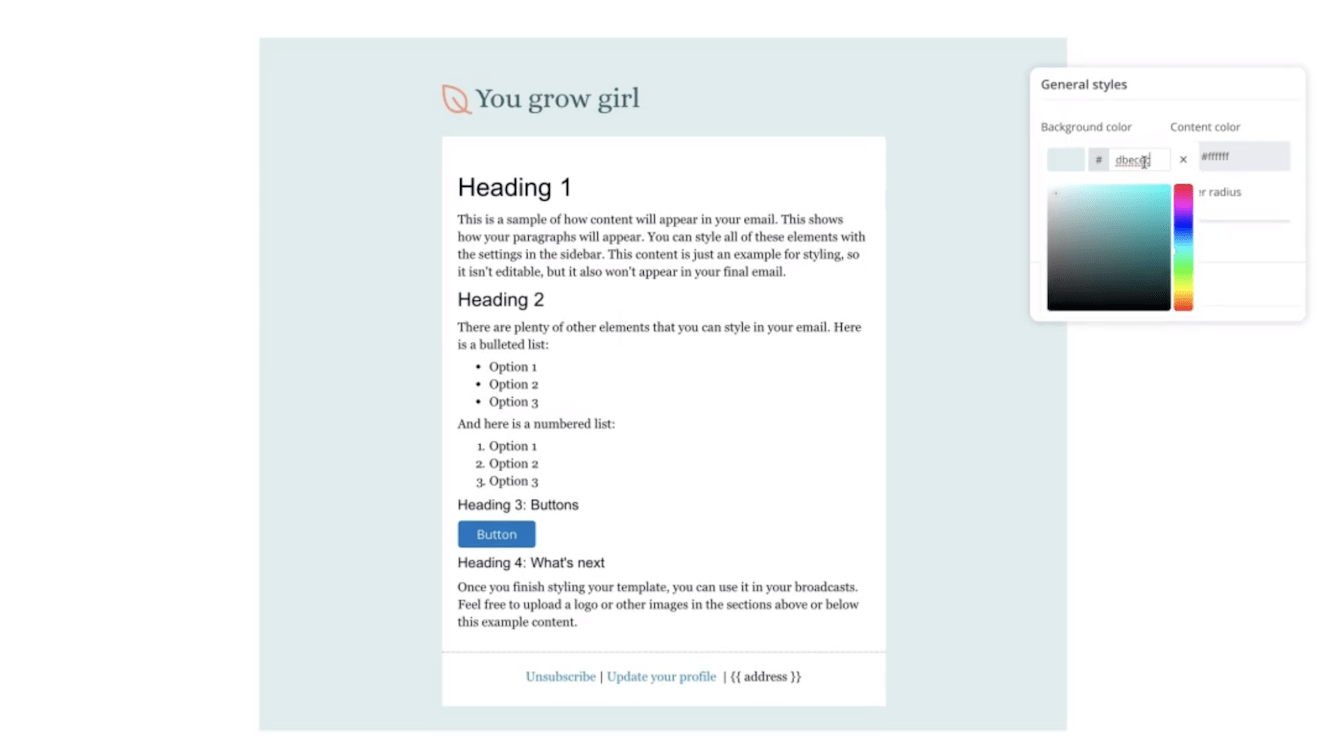
#9 MailerLite
A good option for personal projects
At the opposite end of the price spectrum, we have MailerLite, which is among the best email marketing tools for value for money (it’s free for sending up to 12,000 emails/month to less than 1,000 contacts).
Unlike the other beginner email marketing tools out there, MailerLite is a universally good tool irrespective of industry. Whether you’re growing a small charity, a side-hustle, or are a freelancer starting out, MailerLite offers everything you need to send bulk email marketing campaigns.
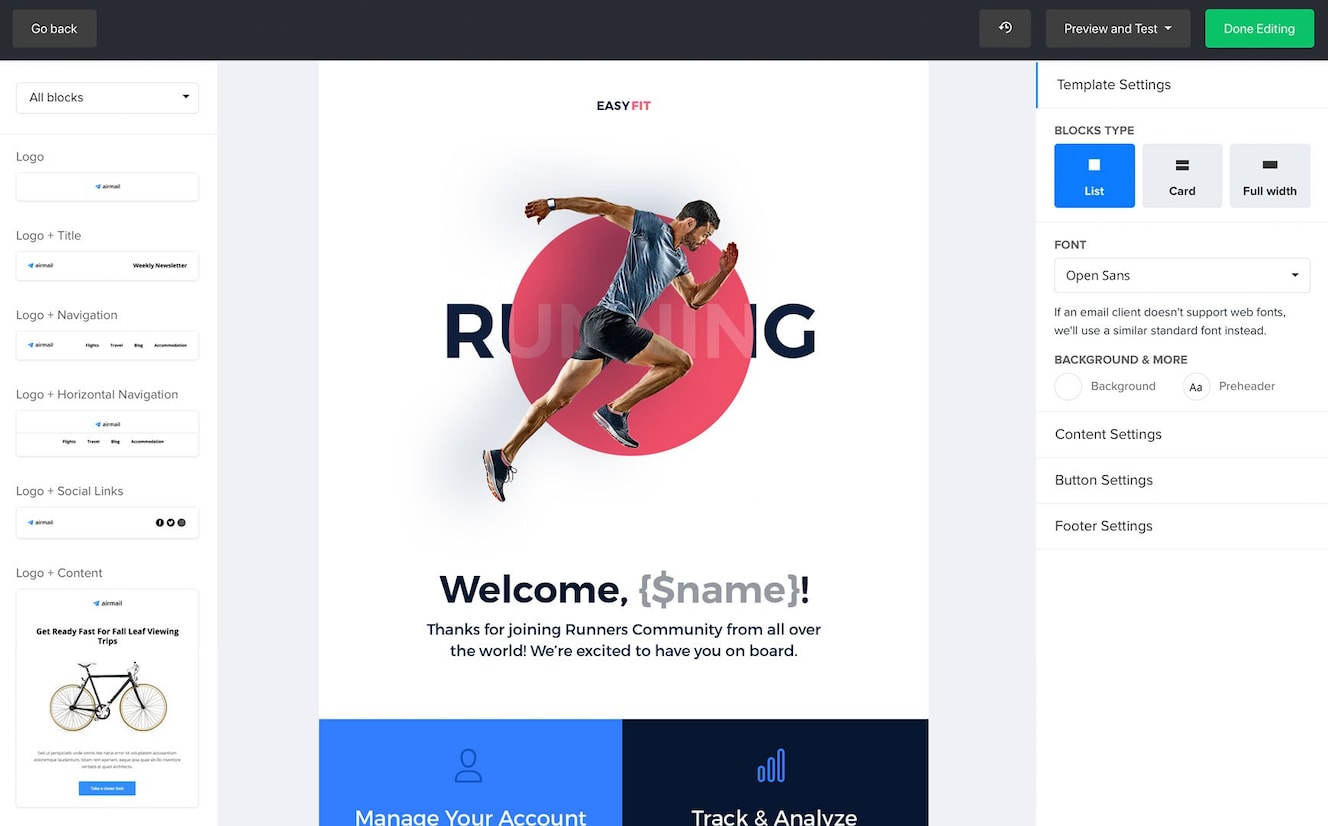
If you’re a small business, I’d suggest that a tool like ActiveCampaign may be a better fit, as they offer an in-built CRM and more advanced marketing features for roughly the same price.
For beginners and personal projects, where you just need to send beautiful email campaigns to engage your audience, MailerLite is ideal.
If you want to give MailerLite a spin, the folks there have kindly offered Venture Harbour readers an extended 30-day trial (instead of 14 days).
#10 EmailOctopus
A good option for developers
There’s long been a notion in email marketing that the most affordable way to send emails is using Amazon’s Simple Email Service (SES). Yet, the UI just isn’t built for marketing teams to create campaigns.
Many email marketing services have tried to bridge this gap – from Sendy to Moonmail, but they’ve often ended up either falling short on features or gravitating towards being more developer-centric.
EmailOctopus have nailed this balance.
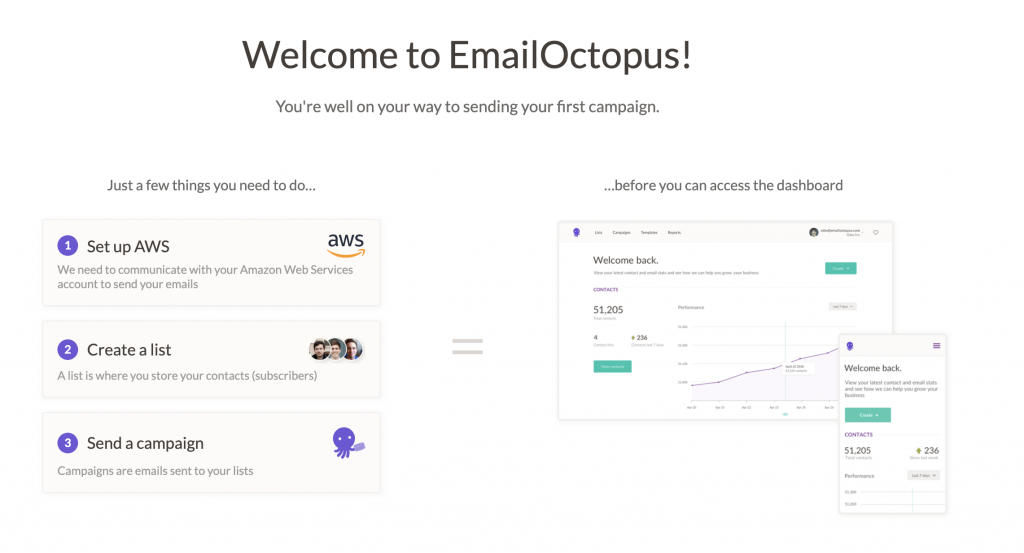
The benefits of Amazon SES, without the drawbacks
Amazon’s Simple Email Service (SES) is unbeatable from a cost perspective, and the deliverability is world-class. But it creates a huge bottleneck if used to send your marketing campaigns.
Every campaign, typo fix, and email sequence must be briefed as a development task, diverting scarce design and development resources to something that, frankly, is a flagrant waste of developer time.
EmailOctopus closes this gap. Built on the back of Amazon SES, EmailOctopus gives you the infrastructure benefits of AWS, while enabling you to build your email campaigns in a friendly UI.
The main downside of EmailOctopus is its simplicity. If you’re just sending email campaigns to a list that’s fine, but don’t expect the multi-touch attribution or visual automation builder that you’d find in a tool like ActiveCampaign.
EmailOctopus would be perfect for a small tech startup, where someone on the team is fluent in AWS and needs the flexibility and power of SES without the creation of the emails themselves needing to be coded.
Having covered the pros and cons of our top ten email marketing tools, we’ll now compare them head-to-head in nine areas that define a great email marketing tool.
What should you look for in email marketing software?
Email marketing software needs to grow your business by saving you time and converting your leads into customers, and those customers into repeat customers – on autopilot.
From surveying 1,700+ marketers in the process of changing their email marketing software, we discovered nine factors that separate the good from the great:
- 💰 Compare Cost
- 😌 Compare UX
- 📮 Compare Deliverability
- ✨ Compare Features
- 🤝 Compare CRMs
- 📊 Compare Reporting
- 🔌 Compare Integrations
- 🙋 Compare Support & Training
- 🔒Compare Security
Of course, every email marketing tool will claim to do well in all areas, yet by analysing data and observing why marketers leave different email platforms, we’re able to capture a far more honest picture.
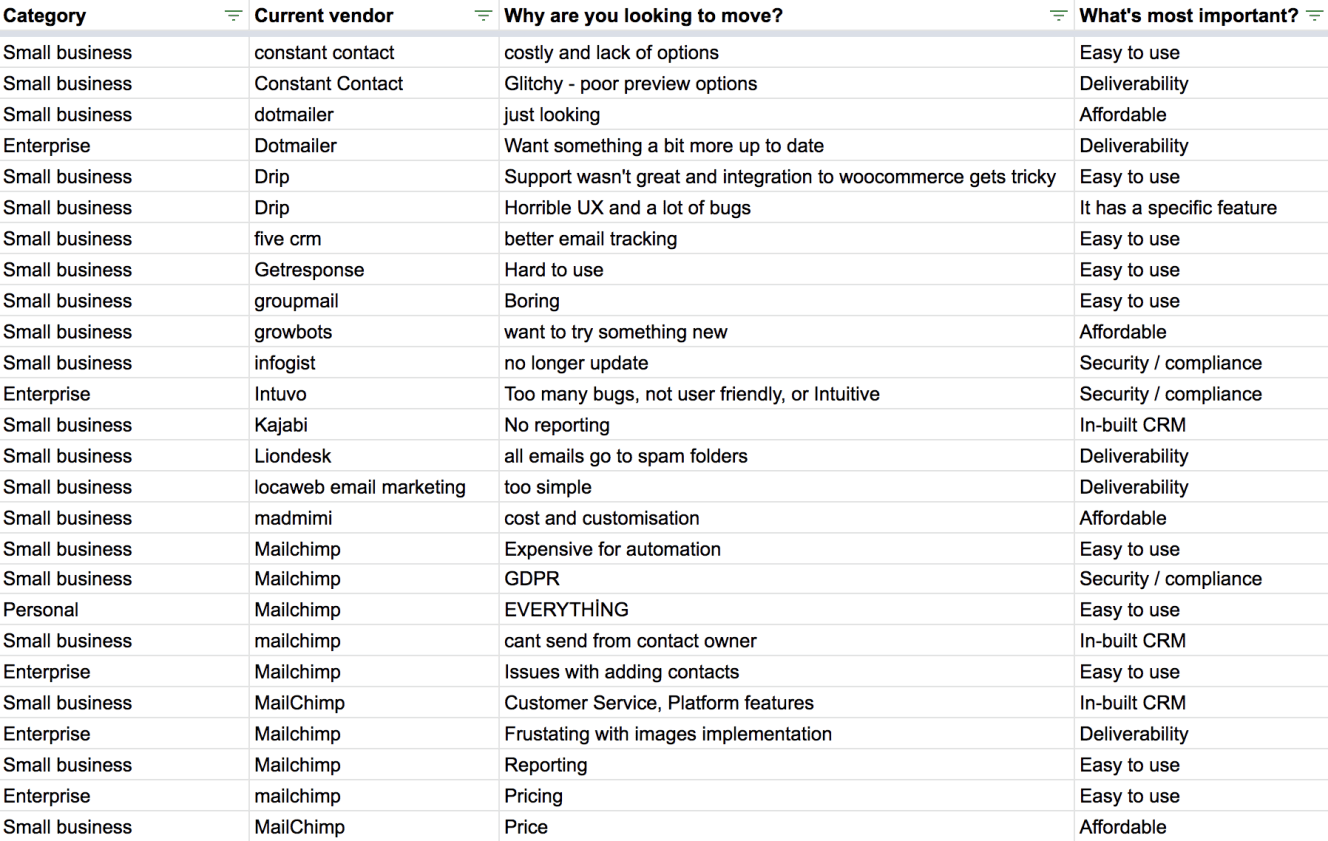
1. Best for affordability
What differentiates a $100/month tool from a $20/month tool?
Sometimes very little, sometimes a lot. HubSpot, for example, may charge 10X more than most email marketing tools but they offer an all-in-one marketing & sales platform that includes everything from landing pages and live chat, to a social media management tool and CRM. On the other hand, ActiveCampaign offers an enormous amount of value while remaining one of the most affordable email marketing tools on the market.
Comparing email marketing software based on cost alone is a dangerous game. That’s why it’s important to look at all nine factors in this article to ensure that you’re buying the right tool for the job, rather than the cheapest.
Conclusion
Let us know your thoughts in the comment section below.
Check out other publications to gain access to more digital resources if you are just starting out with Flux Resource.
Also contact us today to optimize your business(s)/Brand(s) for Search Engines
